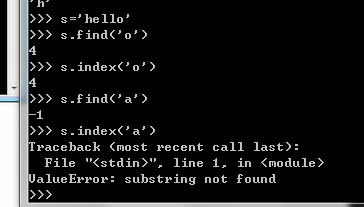python的数据类型
一、数字类型和字符串类型
1.bin()函数将十进制转换成而进制
2.oct()函数将十进制转换成八进制
3.hex()函数将十进制转换成十六进制
十六进制表示:0-9 a b c d e f
4.数字类型的特性:
只能存放一个值
一经定义,不可更改
直接访问
分类:整型,布尔,浮点,复数
5.字符串类型
引号包含的都是字符串类型
S1='hello world' s="hello world"
s2="""hello world"""
s3='''hello world'''
单引双引没有区别
6.字符串的常用操作
strip()移除空白,也可以去除其他的字符
slipt()分割,默认以空格分割。也可以以其他的字符分割
len()长度 切片:如print(x[1:3])也是顾头不顾尾
print(x[0:5:2])#0 2 4
capitalize()首字母大写
center()居中显示例如:x='hello' print(x.center(30,'#'))
count():计数,顾头不顾尾,统计某个字符的个数,空格也算一个字符
endswith()以什么结尾
satrtswith()以什么开头
find()查找字符的索引位置,如果是负数,代表查找失败
index()索引
find()和index()的区别,如下图:

format()字符串格式化
1.msg='name:{},age:{},sex:{}'
print(msg.format('haiyan',18,女))
2.msg='name:{0},age:{1},sex:{0}'
print(msg.format('aaaaaa','bbbbbb'))
3.msg='name:{x},age:{y,sex:{z}'
print(msg.format(x='haiyan',y='18',z='女'))
isdigit()判断是否是数字
islower()判断是否是全部小写
isupper()判断是否是全部大写
lower()全部转换为小写
upper()全部转换为大写
isspace()判断是否是全都是空格
istitle()判断是否是标题(首字母大写)
swapcase()大小写字母翻转
join()连接
repalce()替换
msg='hello alex'
print(msg.replace('e'),'A',1)
print(msg.replace('e'),'A',2)
ljust()左对齐
X='ABC' print(x.ljust(10,'*'))
二、字符串格式化和字符串的一些方法
1.%s,%d
举例1:name='egon'
age=20
print("my name is %s my age is %s" %(name,age))#%s既能接受字符串,也能接受数字
print(‘my name is %s my age is %d’ %(name,age))#%d只能接受数字
举例2:用户信息的显示
1 while True:
2 name=input("name:")
3 age=input("age:")
4 sex=input("sex:")
5 height=input("height:")
6 msg='''
7 ------------%s info-----------
8 name:%s
9 age:%s
10 sex:%s
11 height:%s
12 ------------------------------
13 '''%(name,name,age,sex,heigth)
14 print(msg)
运行结果如下:

2.字符串方法

|
1
2
3
4
5
6
7
8
9
10
11
12
13
14
15
16
17
18
19
20
21
22
23
24
25
26
27
28
29
30
31
32
33
34
35
36
37
38
39
40
41
42
43
44
45
46
47
48
49
50
51
52
53
54
55
56
57
58
59
60
61
62
63
64
65
66
67
68
69
70
71
72
73
74
75
76
77
78
79
80
81
82
83
84
85
86
87
88
89
90
91
92
93
94
95
96
97
98
99
100
101
102
103
104
105
106
107
108
109
110
111
112
113
114
115
116
117
118
119
120
121
122
123
124
125
126
127
128
129
130
131
132
133
134
135
136
137
138
139
140
141
142
143
144
145
146
147
148
149
150
151
152
153
154
155
156
157
158
159
160
161
162
163
164
165
166
167
168
169
170
171
172
173
174
175
176
177
178
179
180
181
182
183
184
185
186
187
188
189
190
191
192
193
194
195
196
197
198
199
200
201
202
203
204
205
|
# name='egon' #name=str('egon')# print(type(name))#优先掌握#1.移除空白strip# msg=' hello '# print(msg)# print(msg.strip())# 移除‘*’# msg='***hello*********'# msg=msg.strip('*')# print(msg)#移除左边的# print(msg.lstrip('*'))#移除右边的# print(msg.rstrip('*'))#用处while True: name=input('user: ').strip() password=input('password: ').strip() if name == 'egon' and password == '123': print('login successfull')#切分split# info='root:x:0:0::/root:/bin/bash'# print(info[0]+info[1]+info[2]+info[3])# user_l=info.split(':')# print(user_l[0])# msg='hello world egon say hahah'# print(msg.split()) #默认以空格作为分隔符#cmd='download|xhp.mov|3000'# cmd_l=cmd.split('|')# print(cmd_l[1])# print(cmd_l[0])# print(cmd.split('|',1))#用处while True: cmd=input('>>: ').strip() if len(cmd) == 0:continue cmd_l=cmd.split() print('命令是:%s 命令的参数是:%s' %(cmd_l[0],cmd_l[1]))#长度len# print(len('hell 123'))#索引# 切片:切出子字符串# msg='hello world'# print(msg[1:3]) #1 2# print(msg[1:4]) #1 2 3# 掌握部分oldboy_age=84while True: age=input('>>: ').strip() if len(age) == 0: continue if age.isdigit(): age=int(age) else: print('must be int')#startswith,endswith# name='alex_SB'# print(name.endswith('SB'))# print(name.startswith('alex'))#replace# name='alex say :i have one tesla,my name is alex'# print(name.replace('alex','SB',1))# print('my name is %s my age is %s my sex is %s' %('egon',18,'male'))# print('my name is {} my age is {} my sex is {}'.format('egon',18,'male'))# print('my name is {0} my age is {1} my sex is {0}:{2}'.format('egon',18,'male'))# print('my name is {name} my age is {age} my sex is {sex}'.format(# sex='male',# age=18,# name='egon'))# name='goee say hello'# # print(name.find('S',1,3)) #顾头不顾尾,找不到则返回-1不会报错,找到了则显示索引# # print(name.index('S')) #同上,但是找不到会报错## print(name.count('S',1,5)) #顾头不顾尾,如果不指定范围则查找所有#join# info='root:x:0:0::/root:/bin/bash'# print(info.split(':'))# l=['root', 'x', '0', '0', '', '/root', '/bin/bash']# print(':'.join(l))#lower,upper# name='eGon'# print(name.lower())# print(name.upper())#了解部分#expandtabs# name='egon\thello'# print(name)# print(name.expandtabs(1))#center,ljust,rjust,zfill# name='egon'# # print(name.center(30,'-'))# print(name.ljust(30,'*'))# print(name.rjust(30,'*'))# print(name.zfill(50)) #用0填充#captalize,swapcase,title# name='eGon'# print(name.capitalize()) #首字母大写,其余部分小写# print(name.swapcase()) #大小写翻转# msg='egon say hi'# print(msg.title()) #每个单词的首字母大写#在python3中num0='4'num1=b'4' #bytesnum2=u'4' #unicode,python3中无需加u就是unicodenum3='四' #中文数字num4='Ⅳ' #罗马数字#isdigt:str,bytes,unicode# print(num0.isdigit())# print(num1.isdigit())# print(num2.isdigit())# print(num3.isdigit())# print(num4.isdigit())#isdecimal:str,unicode# num0='4'# num1=b'4' #bytes# num2=u'4' #unicode,python3中无需加u就是unicode# num3='四' #中文数字# num4='Ⅳ' #罗马数字# print(num0.isdecimal())# # print(num1.)# print(num2.isdecimal())# print(num3.isdecimal())# print(num4.isdecimal())#isnumeric:str,unicode,中文,罗马# num0='4'# num1=b'4' #bytes# num2=u'4' #unicode,python3中无需加u就是unicode# num3='四' #中文数字# num4='Ⅳ' #罗马数字## print(num0.isnumeric())# # print(num1)# print(num2.isnumeric())# print(num3.isnumeric())# print(num4.isnumeric())#is其他# name='egon123'# print(name.isalnum()) #字符串由字母和数字组成# name='asdfasdfa sdf'# print(name.isalpha()) #字符串只由字母组成## name='asdfor123'# print(name.isidentifier())name='egGon'print(name.islower())# print(name.isupper())# print(name.isspace())name='Egon say'print(name.istitle()) |
三、列表
一、列表
作用:多个装备,多个爱好,多门课程,多个女朋友等
定义:[]内可以有多个任意类型的值,逗号分隔
以下是列表的常用操作:

1 l=[1,2,3] #l=list([1,2,3])
2 # print(type(l))
3
4 #pat1===》优先掌握部分
5 # 索引:l=[1,2,3,4,5]
6 print(l[0]) 7 # 切片
8 l=['a','b','c','d','e','f']
9
10 # print(l[1:5])
11 # print(l[1:5:2])
12 # print(l[2:5])
13 # print(l[-1])
14
15
16 #了解
17 # print(l[-1:-4])
18 # print(l[-4:])
19 # l=['a','b','c','d','e','f']
20 # print(l[-2:])
21
22 # 追加
23 # hobbies=['play','eat','sleep','study']
24 # hobbies.append('girls')
25 # print(hobbies)
26
27 # 删除
28 hobbies=['play','eat','sleep','study']
29 # x=hobbies.pop(1) #不是单纯的删除,是删除并且把删除的元素返回,我们可以用一个变量名去接收该返回值
30 # print(x)
31 # print(hobbies)
32
33 # x=hobbies.pop(0)
34 # print(x)
35 #
36 # x=hobbies.pop(0)
37 # print(x)
38
39 #队列:先进先出
40 queue_l=[]
41 #入队
42 # queue_l.append('first')
43 # queue_l.append('second')
44 # queue_l.append('third')
45 # print(queue_l)
46 #出队
47 # print(queue_l.pop(0))
48 # print(queue_l.pop(0))
49 # print(queue_l.pop(0))
50
51
52 #堆栈:先进后出,后进先出
53 # l=[]
54 # #入栈
55 # l.append('first')
56 # l.append('second')
57 # l.append('third')
58 # #出栈
59 # print(l)
60 # print(l.pop())
61 # print(l.pop())
62 # print(l.pop())
63
64 #了解
65 # del hobbies[1] #单纯的删除
66 # hobbies.remove('eat') #单纯的删除,并且是指定元素去删除
67
68
69 # 长度
70 # hobbies=['play','eat','sleep','study']
71 # print(len(hobbies))
72
73 # 包含in
74 # hobbies=['play','eat','sleep','study']
75 # print('sleep' in hobbies)
76
77 # msg='hello world egon'
78 # print('egon' in msg)
79
80
81 ##pat2===》掌握部分
82 hobbies=['play','eat','sleep','study','eat','eat']
83 # hobbies.insert(1,'walk')
84 # hobbies.insert(1,['walk1','walk2','walk3'])
85 # print(hobbies)
86
87 # print(hobbies.count('eat'))
88 # print(hobbies)
89 # hobbies.extend(['walk1','walk2','walk3'])
90 # print(hobbies)
91
92 hobbies=['play','eat','sleep','study','eat','eat']
93 # print(hobbies.index('eat'))
94
95
96 #pat3===》了解部分
97 hobbies=['play','eat','sleep','study','eat','eat']
98 # hobbies.clear()
99 # print(hobbies)
100
101 # l=hobbies.copy()
102 # print(l)
103
104 # l=[1,2,3,4,5]
105 # l.reverse()
106 # print(l)
107
108 l=[100,9,-2,11,32]
109 l.sort(reverse=True)
110 print(l)




 浙公网安备 33010602011771号
浙公网安备 33010602011771号